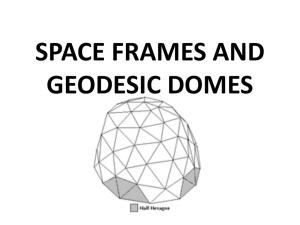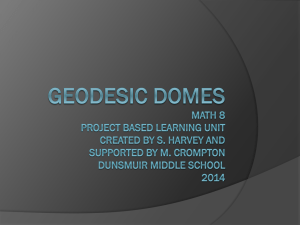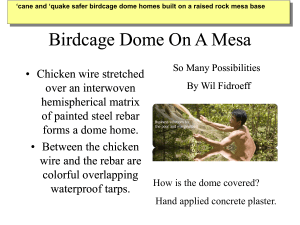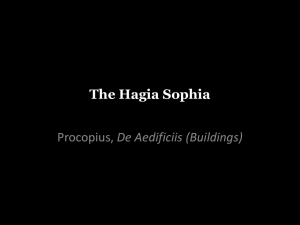Geodesic Dome - Denise Kapler
advertisement
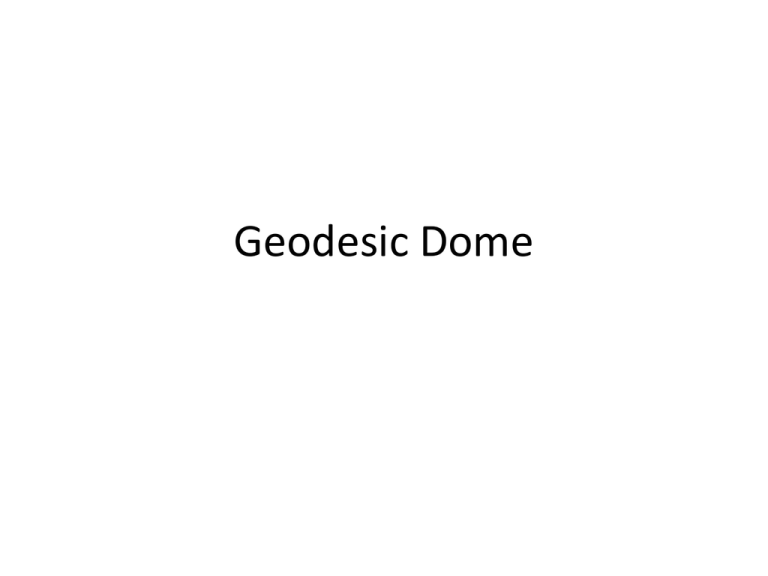
Geodesic Dome The concept of the geodesic dome originated with Buckminster Fuller. He patented his design in 1954. 1. A geodesic dome is a spherical or partial-spherical shell structure based on a network of great circles (geodesics) lying on the surface of a sphere. 2. Buckminster Fuller was the scientist who developed the intrinsic mathematics of the dome, thereby allowing popularization of the idea — for which he received a U.S. patent. 3. A triangle is the only polygon (many-sided) that holds its shape with force acted upon it. 4. Geodesic domes are an extremely efficient form of architecture The dome is energy efficient for many reasons: 1. Its decreased surface area requires less building materials. 2. Exposure to cold in the winter and heat in the summer is decreased because, being spherical, there is the least surface area per unity of volume per structure. 3. The concave interior creates a natural airflow that allows the hot or cool air to flow evenly throughout the dome with the help of return air ducts. 4. Extreme wind turbulence is lessened because the winds that contribute to heat loss flow smoothly around the dome. 5. It acts like a type of giant down-pointing headlight reflector and reflects and concentrates interior heat. This helps prevent radiant heat loss. Geodesic Domes Geodesic means Earth-dividing in Latin Material efficient: uses about 30% fewer physical components than rectangular buildings. We like triangles, too, but we don't think they meant for domes to have interior waterfalls. Lots of seams make for difficult waterproofing, as many dome owners have learned ... the hard way. You'll find children hanging upside down from them at playgrounds. The domes are commonly used as those half-sphere jungle gyms found in parks everywhere. Major Annoyance of Dome Homes: You can almost hear your children think (and that's not necessarily a good thing). Domes transmit sound everywhere, meaning there's very little privacy. To increase living space: add lofts. Lofts let you build higher toward the ceiling while consuming a minimum of floor space with supports. Domes are very strong and stable yet use a fraction of the building materials that other structures require. Inventor of Geodesic Dome - It created a huge sensation throughout his home country, Germany. Walter Bauersfeld built the first dome in Jena. To infinity and beyond! Bauersfeld's dome ceiling was perfect for projecting maps of stars and planets. Geodesic domes owe their strength to the structural principle: Buckminster Fuller just made up that word -- tensegrity. He combined the words "tensional" and "integrity" to describe this principle, which can be used to make super-strong buildings. Inspiration for Buckminster Fuller came from the world about him. Look at this snowflake, man! It's just, like, so cool! Natural shapes inspired Fuller to create efficient geodesic designs, which subsequently inspired many hippies. Super-strong construction and a low center of gravity make these buildings nearly indestructible compared to traditional homes. Triangle is the basic polygon making up the geodesic dome. It's the strongest shape out there. Triangles distribute weight and stress better than any other polygon. 1. The icosahedron's potential for creating new dome designs is infinite. It is a geometric shape made of triangles and is most frequently used to design geodesic domes. It is a 20-sided polyhedron. 2. Eaves and soffits are great for shedding water, but the wind grabs them and won't let go. Domes don't have any overhangs ~ one reason domes are nearly impervious to strong winds Build a Geodesic Dome Need 65 tubes of newspaper or balsa sticks 1. 2. 3. 4. 5. 35 "long" and 30 "short” Cut off both ends to get correct length Long = 71 cm Short = 66 cm Tape 10 longs together to make the base of the dome 7. Tape a long and a short to each joint. Arrange them so that there are two longs next to each other, followed by two shorts, and so on. 8. Tape the tops of the triangles all the way around with a row of shorts. (The dome will start curving inward.) 10.At each joint where four shorts come together, tape another short sticking straight up. Connect this short to the joints on either side with longs, forming new triangles. 11.Connect the tops of these new triangles with a row of longs. 12.Add the last five shorts so that they meet at a single point in the center of the dome. (You might need to stand inside the dome to tape them together.) You may like to test the strength of your dome. Geodesic sphere and its dual. Chord - straight line segment joining two points on a curve "chord" of the "geodesic sphere" corresponds to the structural "strut" of the physical "geodesic dome" Geodesic Dome is a triangulation of a Platonic Solid Platonic Buckminster Fuller Dome In Carbondale, Illinois Fuller hoped that the geodesic dome would help address the post World War II housing crisis. *Did not catch on because of complexity and consequent greater construction costs. Spaceship Earth In Nature Montreal BioSphere Geodesic spheres and domes come in various frequencies. The frequency of a dome relates to the number of smaller triangles into which it is subdivided. A high frequency dome has more triangular components and is more smoothly curved and sphere-like Hoberman - expansion Frequencies Tiling the Sphere
